Welcome to our free classical music site

Do you write about classical music? Are you a blogger? Want to team up with Classical Connect? Send us a message, let's talk!

Do you write about classical music? Are you a blogger? Want to team up with Classical Connect? Send us a message, let's talk!
January 16, 2017. Tieleman Susato. Last week we wrote about Metastasio, a poet and librettist who left an indelible mark on the history of opera; this week we turn to a publisher who was equally important in the development of Renaissance music. Tielman Susato was born sometime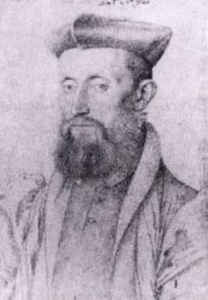 between 1510 and 1515, but where - we are also not sure, probably not far from Cologne, as he referred to himself as “Susato Agrippinus”: Agrippina, the wife of the emperor Claudius, was born in a Roman settlement on the Rhine that later became Cologne, and the Romans renamed it in her honor. We do know that by 1529 Susato was living in Antwerp and working as a calligrapher. A musician, he also joined the town band. He played different wind instruments: the sackbut (an early trombone), the trumpet, flute and recorder. In 1541 he joined two prominent Antwerp printers and eventually acquired the firm. Somewhere around 1542 the firm published its’ first book of music: it was the first not just for Antwerp but for all of Northern Europe – as before that, the Italians dominated the trade.
between 1510 and 1515, but where - we are also not sure, probably not far from Cologne, as he referred to himself as “Susato Agrippinus”: Agrippina, the wife of the emperor Claudius, was born in a Roman settlement on the Rhine that later became Cologne, and the Romans renamed it in her honor. We do know that by 1529 Susato was living in Antwerp and working as a calligrapher. A musician, he also joined the town band. He played different wind instruments: the sackbut (an early trombone), the trumpet, flute and recorder. In 1541 he joined two prominent Antwerp printers and eventually acquired the firm. Somewhere around 1542 the firm published its’ first book of music: it was the first not just for Antwerp but for all of Northern Europe – as before that, the Italians dominated the trade.
The history of music printing starts with the invention of the metal movable print by Johannes Gutenberg; his famous Bible was printed in 1450. Gutenberg didn’t print music, though. It was Ottaviano Petrucci who, about half a century after Gutenberg’s great invention, printed the first book of music sheets. Petrucci used what is called the triple-impression method: on every sheet he would first print the staff lines, then the words and then the notes. This process created a high-quality page but was very time-consuming. In 1520 the single-impression method was developed: all components were printed together, and even though the results were messier, the single-impression method won over as it was much simpler and faster in production. It was this single-impression technique that Susato used to print his first music book, Quatuor vocum musicae modulations, a collection of four-part motets by a dozen different composers, one of whom was Susato himself.
Sometime around 1544 Susato met the composer Jacob Clemens non Papa who had recently moved to Antwerp. They became good friends and several years later Susato published Clemens’s most famous work: his setting of 150 psalms called Souterliedekens (Little Psalter Songs in Flemish). Susato also published important books of music by Josquin des Prez andOrlando di Lasso. For example, his 1545 Quatuor vocum musicae modulations, printed 24 years after Josquin’s death, is the first book, whether in manuscript form or in print, containing many of Josquin’s chansons.
Susato was also quite a prolific composer, although not on the same level as some of the greats whose music he published. His instrumental dances are pleasing. Here, for example, is a Ronde from his collection of dance music usually called Dansereye (it’s performed by the ensemble New London Consort). By the end of his life Susato moved to Sweden; there’s no record of him past 1570. Susato, who was important in improving the printing technology (he developed new music fonts) should be especially remembered for making music more accessible to the people; he concentrated on publishing the music of his fellow Flemish composers, and that was exactly when Flemish music had reached its heights. The composers he published were among the most important ones, whether they worked in Flanders, in Rome, or anywhere else in Europe.Permalink
January 9, 2017. Pietro Metastasio. This week is a bit short on talent (one exception is Morton Feldman, who was born on January 12th of 1926; we wrote about him two years ago). On the other hand, the previous week was brimming with it. Although we usually write about composers, a person who left a mark as significant as any of the greatest composers was a.jpg) poet and librettist, Pietro Metastasio. Metastasio wrote 27 librettos for opera seria, some of which were set many times by different composers (his La clemenza di Tito was used by 40 composers, from Antonio Caldara to Christoph Gluck, Josef Mysliveček and, finally, Mozart). Altogether almost 400 composers had used Metastasio’s poetry to create musical pieces from operas and oratorios to cantatas and songs, among them, in addition to the ones mentioned above, Nicola Porpora, Baldassare Galuppi, George Frideric Handel, Johann Adolph Hasse (who set nearly all of Metastasio’s opera librettos), Paisiello and Meyerbeer. Metastasio was born Pietro Trapassi in Rome on January 3rd of 1698. His godfather was the famous patron of music and arts, Cardinal Pietro Ottoboni. As a child, Pietro developed an amazing ability to improvise in verse on any given subject. During one of his public performances he was noticed by Giovanni Vincenzo Gravina, one of the founders of the Accademia degli Arcadi (the Academy of Arcadians), a famous literary and music society (Cardinal Ottoboni was also an Arcadian). Gravin took young Pietro under his wing and later adopted him, changing his name to Metastasio, which was more or less a translation of his Italian name into Greek: as musicologist Richard Taruskin writes, “trapasso” means transit from one place to another, while “metastasis” means spread or transference. Gravina sent Pietro to study Latin and law in Scalea,Calabria. At the age of 12 Pietro translated the Illiad into Italian and at 14 he composed a tragedy. He was 16 when Garvina died and left Metastasio 15,000 scudi, a considerable sum (translating values of 17th century currency is a very inexact science, but 15,000 scudi could be worth as much as $400,000 in current dollars. That didn’t stop Metastasio from spending it all in just two years!). He moved to Naples to practice law but he was much more interested in poetry. Several of his poems were set to music by Nicola Porpora. Around that time, he met Porpora’s pupil, the castrato Farinelli, who eventually became the most famous singer in all of Europe. Metastasio and Farinelli remained friends for the rest of their lives. Metastasio moved to Rome, got involved with the Accademia and found a patron in a famous soprano Marianna Bulgarelli. Bulgarelli had a salon that was visited by all Roman luminaries of the time. It’s there that he met Alessandro Scarlatti, Hasse, Pergolesi, Leonardo Vinci and Benedetto Marcello. It was a very productive time for Metastasio: in about a year he wrote six libretti, including the famous Didone abbandonata, which was eventually used more than 50 times.
poet and librettist, Pietro Metastasio. Metastasio wrote 27 librettos for opera seria, some of which were set many times by different composers (his La clemenza di Tito was used by 40 composers, from Antonio Caldara to Christoph Gluck, Josef Mysliveček and, finally, Mozart). Altogether almost 400 composers had used Metastasio’s poetry to create musical pieces from operas and oratorios to cantatas and songs, among them, in addition to the ones mentioned above, Nicola Porpora, Baldassare Galuppi, George Frideric Handel, Johann Adolph Hasse (who set nearly all of Metastasio’s opera librettos), Paisiello and Meyerbeer. Metastasio was born Pietro Trapassi in Rome on January 3rd of 1698. His godfather was the famous patron of music and arts, Cardinal Pietro Ottoboni. As a child, Pietro developed an amazing ability to improvise in verse on any given subject. During one of his public performances he was noticed by Giovanni Vincenzo Gravina, one of the founders of the Accademia degli Arcadi (the Academy of Arcadians), a famous literary and music society (Cardinal Ottoboni was also an Arcadian). Gravin took young Pietro under his wing and later adopted him, changing his name to Metastasio, which was more or less a translation of his Italian name into Greek: as musicologist Richard Taruskin writes, “trapasso” means transit from one place to another, while “metastasis” means spread or transference. Gravina sent Pietro to study Latin and law in Scalea,Calabria. At the age of 12 Pietro translated the Illiad into Italian and at 14 he composed a tragedy. He was 16 when Garvina died and left Metastasio 15,000 scudi, a considerable sum (translating values of 17th century currency is a very inexact science, but 15,000 scudi could be worth as much as $400,000 in current dollars. That didn’t stop Metastasio from spending it all in just two years!). He moved to Naples to practice law but he was much more interested in poetry. Several of his poems were set to music by Nicola Porpora. Around that time, he met Porpora’s pupil, the castrato Farinelli, who eventually became the most famous singer in all of Europe. Metastasio and Farinelli remained friends for the rest of their lives. Metastasio moved to Rome, got involved with the Accademia and found a patron in a famous soprano Marianna Bulgarelli. Bulgarelli had a salon that was visited by all Roman luminaries of the time. It’s there that he met Alessandro Scarlatti, Hasse, Pergolesi, Leonardo Vinci and Benedetto Marcello. It was a very productive time for Metastasio: in about a year he wrote six libretti, including the famous Didone abbandonata, which was eventually used more than 50 times.
In 1730 Metastasio was invited to Vienna to the court of Emperor Charles VI in the official position of the “Italian court poet.” It paid handsomely – 3, 000 florins, higher than the salary of the Kapellmeister. The Emperor paid another 1,000 florins out of his personal purse. Metastasio settled in Vienna in the summer of 1730. He was 32 and had another 50 years in front of him (we’ll write about the second phase of his life another time). Now we’ll present an aria from an opera written to one of his most popular librettos, Il re pastore (The Shepherd King). It was written by Metastasio in 1751 and then used by Hasse, Gluck, Piccini, Galippi – and Mozart, who created a masterpiece. Here’s Kiri Te Kanawa in L'amerò, sarò costante from Il re. The London Symphony Orchestra is conducted by Sir Colin Davis.Permalink
January 2, 2017. Happy New Year to all! As we look forward to another year of great music, we’d like to remember some of the musicians who left us in 2016. Pierre Boulez, a towering figure in classical music of the last 60 years, died on January 5th at the age of 90. Boulez was a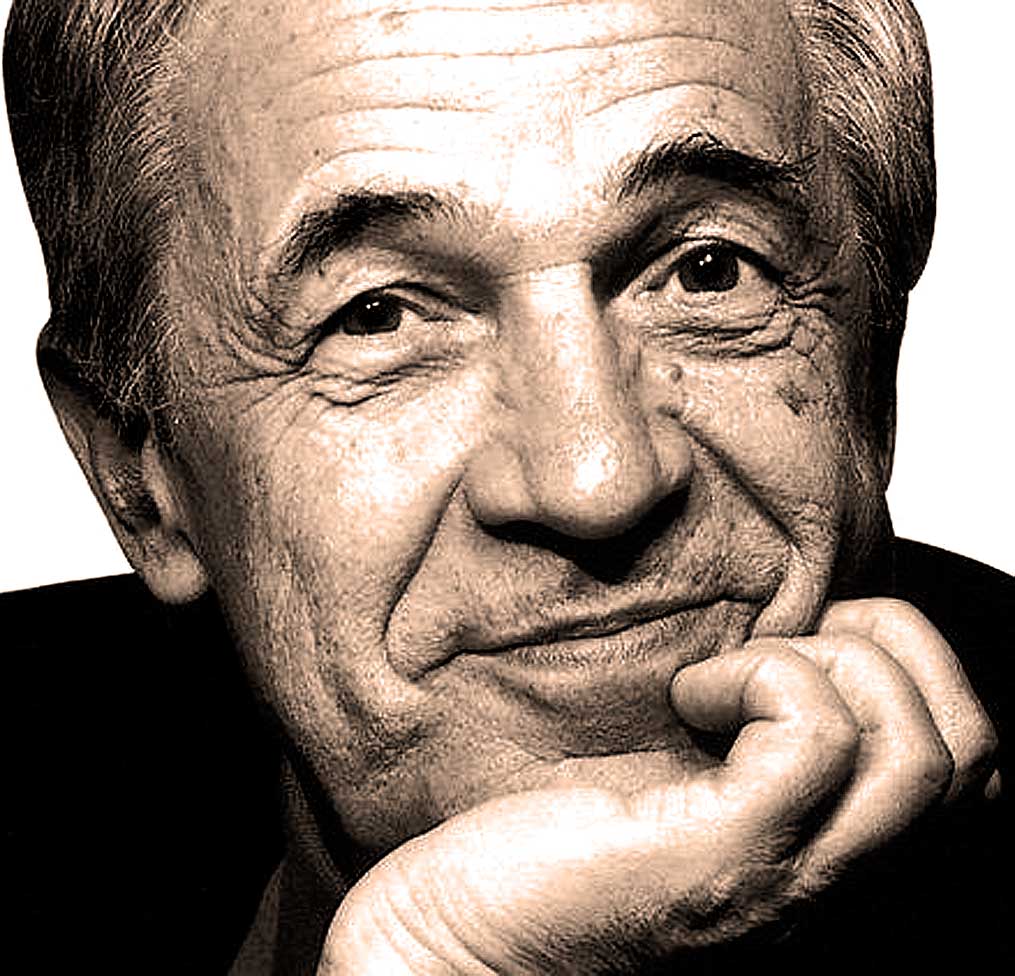 composer, conductor, writer, speaker, music organizer – he did it all. A student of Olivier Messiaen, he started composing in the late 1940s. He soon became one of the better-known proponents of serialism. Together with his friends Karlheinz Stockhausen, Luciano Berio and Bruno Maderna, he was a central figure in the Darmstadt School, a hugely influential group of young modernist composers who attended summer courses in the German city. He started conducting in the late 1950, initially specializing in modern music but eventually expanding his repertoire to cover large parts of orchestral literature; he became especially known for his interpretation of French music and, somewhat surprisingly, Gustav Mahler, esthetically his opposite. In the late 70s, on a suggestion of President Pompidou, he organized an institute for musical research, the famous IRCAM. IRCAM became a laboratory for new music, especially electronic. Within it, Boulez organized his own ensemble, called Ensemble Intercontemporain, with which he toured around the world. While at IRCAM, Boulez staged several important opera productions, from Wagner to Berg’s Lulu. In the 1990s he returned to conducting, working with major orchestras: the Chicago Symphony, the London Symphony, the Cleveland, the Vienna Philharmonic and many others, maintaining an amazing schedule. Health problems forced Boulez to slow down in the last 10 years of his life, but he continued making music almost till the end of his life. His last composition was completed in 2006. Boulez died in Baden-Baden and was buried there.
composer, conductor, writer, speaker, music organizer – he did it all. A student of Olivier Messiaen, he started composing in the late 1940s. He soon became one of the better-known proponents of serialism. Together with his friends Karlheinz Stockhausen, Luciano Berio and Bruno Maderna, he was a central figure in the Darmstadt School, a hugely influential group of young modernist composers who attended summer courses in the German city. He started conducting in the late 1950, initially specializing in modern music but eventually expanding his repertoire to cover large parts of orchestral literature; he became especially known for his interpretation of French music and, somewhat surprisingly, Gustav Mahler, esthetically his opposite. In the late 70s, on a suggestion of President Pompidou, he organized an institute for musical research, the famous IRCAM. IRCAM became a laboratory for new music, especially electronic. Within it, Boulez organized his own ensemble, called Ensemble Intercontemporain, with which he toured around the world. While at IRCAM, Boulez staged several important opera productions, from Wagner to Berg’s Lulu. In the 1990s he returned to conducting, working with major orchestras: the Chicago Symphony, the London Symphony, the Cleveland, the Vienna Philharmonic and many others, maintaining an amazing schedule. Health problems forced Boulez to slow down in the last 10 years of his life, but he continued making music almost till the end of his life. His last composition was completed in 2006. Boulez died in Baden-Baden and was buried there.
Two very important conductors of chamber orchestras died last year: Sir Neville Marriner on October 2nd (he was 92), and Nikolaus Harnoncourt – on March 5th; Harnoncourt was 86. Neville Marriner, who started his music career as a violinist, was the founder of the world-famous Academy of St Martin in the Fields. Working with that orchestra he became one of the most recorded conductors in modern history. The Academy of St Martin in the Fields started in 1958 as a small ensemble without a conductor, but expanded to a chamber orchestra shortly after. The violinist Iona Brown, who became the conductor of the Academy following Marriner, and Christopher Hogwood, who later organized his own Academy of Ancient Music, were early members of the group. The Academy and other chamber orchestras that Marriner organized later, used modern instruments and modern interpretive approaches. The orchestra’s recordings were technically brilliant, never ponderous and always a pleasure to listen to. Nikolaus Harnoncourt’s approach was very different: he was one of the leaders of the “period,” or “historically informed” performances and his ensembles were one of the first to use period instruments. Harnoncourt, a cellist, organized Concentus Musicus Wien in 1953. He was then playing in the Vienna Symphony (Vienna’s “second orchestra”) and most musicians came from that orchestra. Harnoncourt and his colleagues researched the repertoire and performance technique for four years before giving their first official concert in 1957. During that time the musicians leaned to play different viols rather than modern violins, violas and cellos; Harnoncourt himself switched from the cello to viola da gamba. The ensembled played rarely heard pieces, like operas of Monteverdi and Rameau and made first “authentic” recording of Bach’s St. Matthew Passion. In an unusual feat, Concentus recorded all of Bach’s cantatas. In his later years, Harnoncourt turned to amore standard repertoire and for several years worked with the Royal Concertgebouw Orchestra. He also conducted the Vienna Philharmonic, the Berlin Philharmonic and successfully staged several operas.
We’d also like to note the wonderful Hungarian pianist Zoltán Kocsis, who died on November 6th at the age of 64. A great virtuoso with a repertoire stretching from Bach to Kurtág, he was especially well known for his interpretation of the works of his compatriot, Béla Bartók: Kocsis recorded all of his solo piano works and piano concertos. In 1983, together with Iván Fischer, Koscis founded the Budapest Festival Orchestra, and since 1997 lead the Hungarian National Philharmonic. Koscis performed with all major orchestras and in 2013 received the Gramophone award for his recordings of Debussy. Permalink
December 26, 2016. Christmas 2016. Merry Christmas to all our listeners! It's become a tradition to play excerpts from Bach’s Christmas Oratorio around this time. The Oratorio was written for the Christmas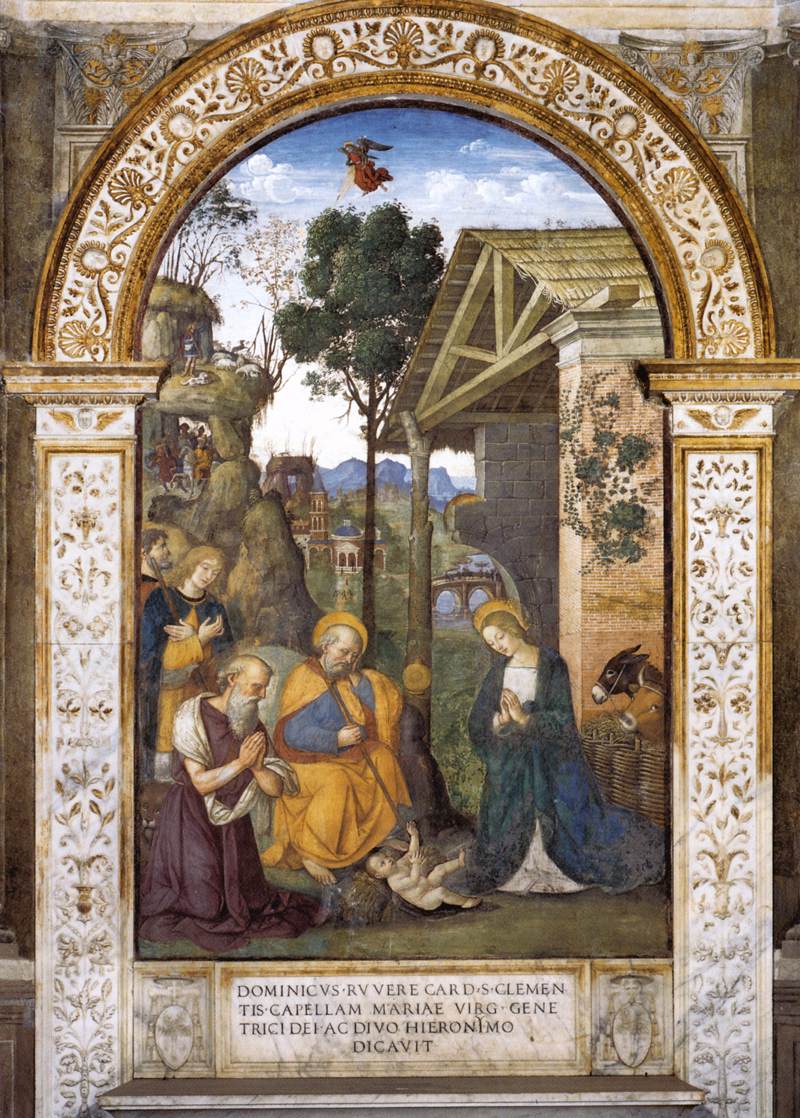 season of 1734, when Bach was the Cantor of the Thomasschule and the most important musician in Leipzig. The oratorio wasn’t completely original: it incorporated music from several previously written cantatas. The text was supplied by Picander, a poet, librettist and a frequent Bach collaborator. We've already played the complete Part I, which describes the birth of Jesus, the first movement (Sinfornia) of Part II (here) and the wonderful alto aria Schlafe, mein Liebster, genieße der Ruh (Sleep, my beloved, enjoy Your rest), here. The Second part was written for the second day of Christmas, or December 26th and describes the Annunciation to the Shepherds. On the day of the premier, it was actually performed twice: first, in the early morning of the 26th, in Thomaskirche, and in the afternoon – in the Nikolaikirche. The second part incorporates music from two cantatas, BWV 213 Laßt uns sorgen and BWV 214, Tönet, ihr Pauken! You can listen to the complete Part II of Christmas Oratorio here. It runs for about 27 minutes. John Eliot Gardiner conducts the English Baroque Soloists and the Monteverdi Choir. Bernarda Fink is the alto, Christoph Genz is the tenor.
season of 1734, when Bach was the Cantor of the Thomasschule and the most important musician in Leipzig. The oratorio wasn’t completely original: it incorporated music from several previously written cantatas. The text was supplied by Picander, a poet, librettist and a frequent Bach collaborator. We've already played the complete Part I, which describes the birth of Jesus, the first movement (Sinfornia) of Part II (here) and the wonderful alto aria Schlafe, mein Liebster, genieße der Ruh (Sleep, my beloved, enjoy Your rest), here. The Second part was written for the second day of Christmas, or December 26th and describes the Annunciation to the Shepherds. On the day of the premier, it was actually performed twice: first, in the early morning of the 26th, in Thomaskirche, and in the afternoon – in the Nikolaikirche. The second part incorporates music from two cantatas, BWV 213 Laßt uns sorgen and BWV 214, Tönet, ihr Pauken! You can listen to the complete Part II of Christmas Oratorio here. It runs for about 27 minutes. John Eliot Gardiner conducts the English Baroque Soloists and the Monteverdi Choir. Bernarda Fink is the alto, Christoph Genz is the tenor.
The fresco above, Adoration of the child with St. Jerome, is by Pinturicchio. It’s located in the Della Rovere Chapel of the church of Santa Maria del Popolo in Rome. It was created in or around 1484, 150 years before the Oratorio.Permalink
December 19, 2016. Dunstaple, Des Prez and Victoria. As the end of the year approaches, we’d like to commemorate some of the composers, most of them of the Renaissance era, that fall off our regular calendar, as their birthdates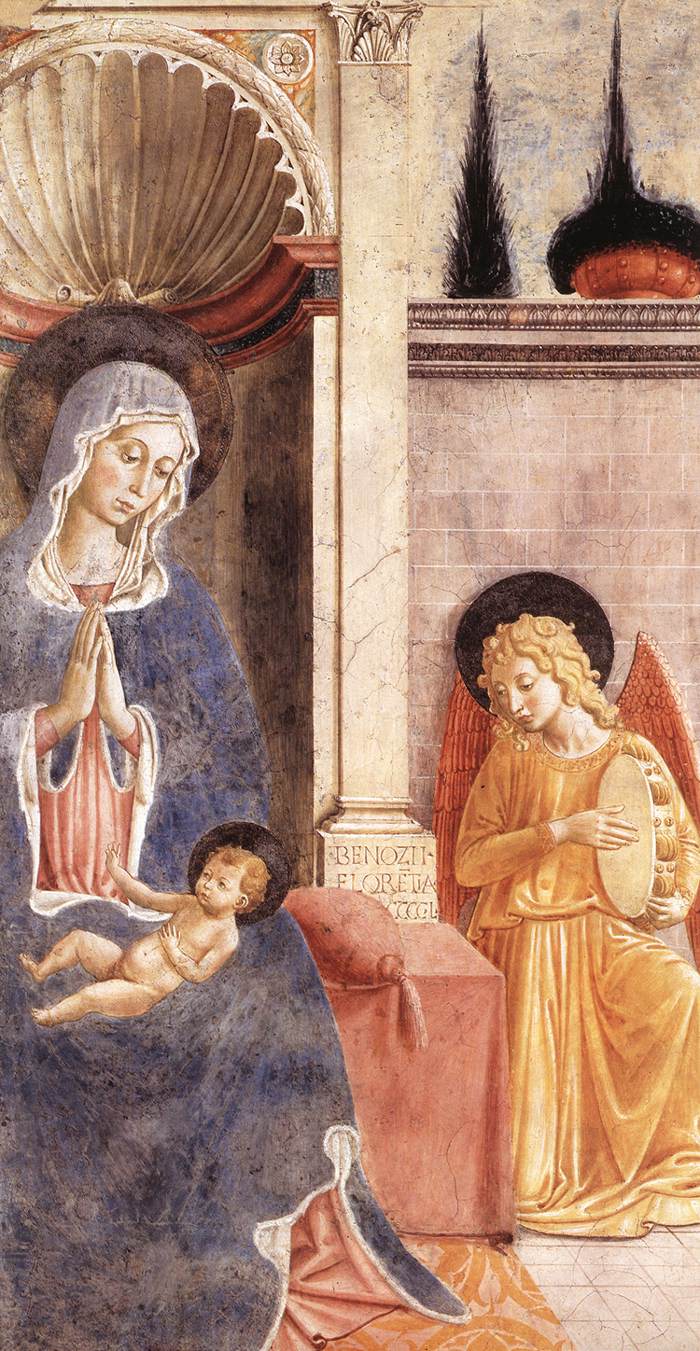 remain unknown to us. It’s especially appropriate as Christmas is approaching and most works of that time were liturgical in nature. John Dunstaple was born around 1390. He served in the court of John of Lancaster, a son of King Henry IV and a brother of Henry V. John led the British forces in many battles of the Hundred Year War with France (he was the one to capture Joan of Arc) and for several years was the Governor of Normandy. It’s likely that Dunstaple stayed with John in Normandy. From there his music spread around the continent, which is quite remarkable considering that a major war was raging in France. Dunstaple’s influence was significant, especially affecting musicians of the Burgundian school; the reason was both musical and political, as Burgundy was allied with England in its war against France. Dunstaple’s La Contenance Angloise, (“English manner”) influenced not only the two greatest composers of Burgundy, Guillaume Dufay and Gilles Binchois but even musicians of the generation that followed, like Ockeghem and Busnoys. Here’s Dunstaple’s motet Quam Pulchra Es, performed by the Hilliard Ensemble.
remain unknown to us. It’s especially appropriate as Christmas is approaching and most works of that time were liturgical in nature. John Dunstaple was born around 1390. He served in the court of John of Lancaster, a son of King Henry IV and a brother of Henry V. John led the British forces in many battles of the Hundred Year War with France (he was the one to capture Joan of Arc) and for several years was the Governor of Normandy. It’s likely that Dunstaple stayed with John in Normandy. From there his music spread around the continent, which is quite remarkable considering that a major war was raging in France. Dunstaple’s influence was significant, especially affecting musicians of the Burgundian school; the reason was both musical and political, as Burgundy was allied with England in its war against France. Dunstaple’s La Contenance Angloise, (“English manner”) influenced not only the two greatest composers of Burgundy, Guillaume Dufay and Gilles Binchois but even musicians of the generation that followed, like Ockeghem and Busnoys. Here’s Dunstaple’s motet Quam Pulchra Es, performed by the Hilliard Ensemble.
Josquin des Prez, one of the greatest Franco-Flemish composers, was born around 1450, probably in the County of Hainaut, which occupied the land on the border between modern-day Belgium and France but back then was part of the Duchy of Burgundy (it was inherited by the dukes at the end of the 14th century). The Duchy was one of the most developed European realms, both economically and artistically. Philip the Good, the duke who ruled from 1419 to 1467, was famous as a patron of painters, Jan van Eyck and Roger van der Weyden among them. Guillaume Dufay, the most renowned composer of his time, worked in duke’s employ. Very little is known about Josquin’s youth. It’s assumed that around 1477 he traveled to Aix-en-Provence and was a singer in the chapel of René, Duke of Anjou. Around 1480 he worked in Milan, probably in the service of Cardinal Ascanio Sforza. And it was probably Sforza who introduced Josquin to the Papal court in Rome. From 1489 to 1495 Josquin sang in the papal choir; a wall of the Sistine Chapel bears a graffito with his name. All the while he was also composing: we know that some of his motets are dated to those years. He probably moved to Milan around 1498 to work for the Sforzas again, and after Milan fell to the French he moved to France. In 1503 he was hired by Ercole, the Duke of Ferrara. It was here that he composed the popular Miserere, a motet for five voices in plainchant, which was probably inspired by the life and execution of Girolamo Savonarola (you can listen to it here, performed by the ensemble De Labyrintho, Walter Testolin conducting). In 1504 Josquin left Ferrara and returned to Condé-sur-l'Escaut, not far from where he was born. He lived there till his death in 1521.
We started at the very beginning of the music of the Renaissance and here is a piece that was written toward the end of it, the exquisite Taedet Animam Meam (My soul is weary of my life) by one of the greatest composers of the High Renessaince, Tomás Luis de Victoria. Victoria was born in 1548 in Spain, near the city of Ávila, spent 20 years in Rome but then returned to Spain. Taedet is one of his last compositions, written in 1605.Permalink
December 12, 2016. Beethoven. This week we celebrate Ludwig van Beethoven’s 236th birthday. He was baptized on December 17th of 1770, so it’s often assumed that he was born the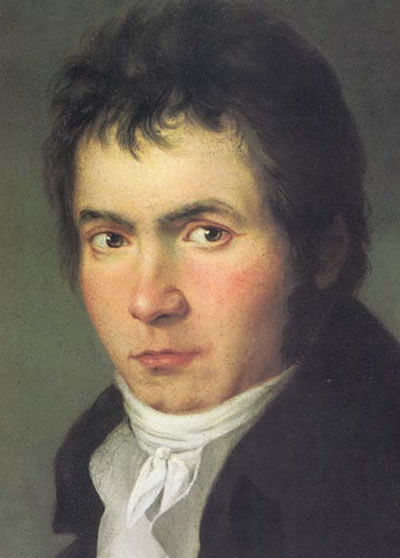 day before, on December 16th. We alternate the celebration by either focusing on the piano sonatas written during a certain period, or on his symphonies. Last year it was symphonies nos. 3 and 4, and today we’ll present the next one, probably his most celebrated, symphony no. 5. It was written between 1804 and 1808 and premiered in Vienna on December 22nd of 1808 with Beethoven conducting (it’s worth reading about the amazing concert at which the Symphony was presented: events like that do not happen often, if ever). The Fifth is one of the most recorded compositions in history so to select one is impossible. We wanted to go for a Furtwangler recording, but their audio quality isn’t great. Everybody knows the Karajans (there are several and practically all are wonderful), so we decided on a superb recording made in 1975 by the late Carlos Kleiber with the Vienna Symphony Orchestra. Enjoy it here. ♫
day before, on December 16th. We alternate the celebration by either focusing on the piano sonatas written during a certain period, or on his symphonies. Last year it was symphonies nos. 3 and 4, and today we’ll present the next one, probably his most celebrated, symphony no. 5. It was written between 1804 and 1808 and premiered in Vienna on December 22nd of 1808 with Beethoven conducting (it’s worth reading about the amazing concert at which the Symphony was presented: events like that do not happen often, if ever). The Fifth is one of the most recorded compositions in history so to select one is impossible. We wanted to go for a Furtwangler recording, but their audio quality isn’t great. Everybody knows the Karajans (there are several and practically all are wonderful), so we decided on a superb recording made in 1975 by the late Carlos Kleiber with the Vienna Symphony Orchestra. Enjoy it here. ♫
Symphony no. 5. As familiar and beloved as the Eroica, Seventh, or Choral Symphonies may be, none approach the immortal status of Beethoven’s own Symphony No. 5. Not only is it the one work most associated with its composer’s name, it is the work most synonymous with the word “symphony” itself. The hammer blows of its opening notes, so well-known even outside of classical music, are instantly recognizable. Even to merely distinguish the symphony by its key – “the C minor” – conjures the same association as saying “Beethoven’s Fifth.”
Beethoven began work on what would become the Fifth Symphony in 1805, shortly after completing the Eroica. As was mentioned in the discussion of the Symphony No. 4, a possible combination of artistic judgment – that so stern a composition as the projected C minor Symphony should not follow one as equally grand and serious – and his engagement to the Countess Theresa Brunswick prompted Beethoven to temporarily set aside the C minor and compose instead the ebullient Symphony in B-flat major. The C minor Symphony was then taken back up in 1807 and completed in 1808. Thus, the composition of the work spans much of Beethoven’s doomed engagement to the Countess – its first sketches predating the engagement, and its completion occurring during the troublesome period in which the lovers were separated, which led eventually to Beethoven himself breaking off the engagement in 1810. The completion of the C minor Symphony also coincided with the composition of its successor, the Pastoral. Both works were jointly dedicated to Prince Lobkowitz and Count Rasumovsky, premiered together in 1808, and published the following year.
The premiere took place on December 22, 1808 in Vienna during a colossal program directed by the composer himself that included the Pastoral Symphony, selections from the Mass in C, the Fourth Piano Concerto, and the Choral Fantasy. Curiously, on that program, the Pastoral Symphony was performed first and given as No. 5, while the C minor was performed during the concert’s latter half and designated as No. 6. The numbers were not reversed until the publication of the score and parts the following year. Despite a program filled with such remarkable compositions, the premiere of the Fifth Symphony was rather lackluster. The sheer length of the concert exhausted the audience, and the orchestra was ill-prepared for the Herculean task. However, it was not long before the Symphony met with success. E. T. A. Hoffman penned an enthusiastic and lavish review of the work in the Allgemeine musikalische Zeitung. It premiered in England in 1816, in Paris in 1828, and was performed in the inaugural concert of the New York Philharmonic in 1842. By then, it was a staple of the orchestra repertoire, even outpacing Beethoven’s other symphonies in number of performances. (Continue reading here).
Permalink